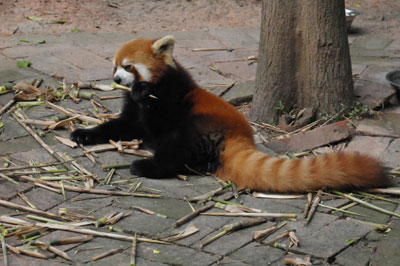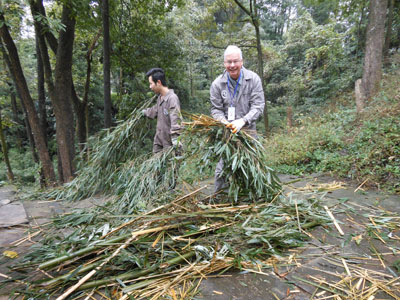Playing with pandas in central China
This article appears on page 18 of the May 2014 issue.

Gail Newlin — Troy, MI
When I think of China, the first thing that comes to mind are pandas. With their black-and-white coats, Mickey Mouse ears and Buddha bellies, they inspire an irresistible urge to hug them. So I had to add “holding a panda” to my list of things to do before I die.
Making plans
During a late-night Google search, I discovered companies advertising panda tours. After many emails, my husband, Richard, and I chose an 11-day tour with Keith Jones, Adventures with Wild Animals (Surprise, AZ; 562/889-4016, www.greywhale.com), which cost $3,595 per person, excluding flights to and from China.
Keith has led panda tours for 10 years, and this tour was scheduled for October 2013, when the weather would be ideal and the baby pandas would be a few months old. All meals, airport transfers, internal flights, admission fees and an opportunity to hold a 2-year-old panda were included; there was no single supplement.
Participants volunteer to work at the Bifengxia preserve for two days cleaning enclosures, feeding the pandas and helping to weigh them. Yes, we were paying to clean up panda poop! However, knowing that we could get up close and personal with pandas would make it all worthwhile.
Before the trip, we looked into vaccinations. Inoculations against Hepatitis A and B and tetanus were recommended. We also had to provide to the panda preserve a signed note from a doctor stating that we did not have any communicable diseases.
Three months prior to departure we applied for a China visa ($337 for two people). We arranged our flights to Beijing, ourselves.
After a smooth 14-hour flight, we landed and were met by Keith Jones, himself. He recommended that we use the airport ATM to obtain Chinese yuan, as it can take 30 to 60 minutes to do this at a local bank.
There was a total of four people on this tour plus Keith and a local guide.
Beginning in Beijing
Our trip began in Beijing, then we would travel to Xi’an, Chengdu and the panda preserve outside Ya’an. Our base in Beijing was the Redwall Hotel. It was comfortable and offered free WiFi, plus you couldn’t beat its location, only a 15- to 20-minute walk from the Forbidden City and Tiananmen Square.
Our tour started at the Summer Palace. We climbed the many steps up the hill to see a temple with walls covered with images of Buddha. Then we walked the palace grounds over to the Marble Boat, actually a pavilion. From there we took a dragon boat across the lake to an island, where we crossed an arched bridge decorated with 500 stone lions.
Lunch was at a hot-pot restaurant. A boiling cauldron of broth was placed in the middle of the table and we dropped thinly sliced meats, vegetables and noodles into it to cook. After they were cooked, we dipped them into various sauces. Call it a Chinese fondue!
Tip for dining in China — take a fork with you if you don’t use chopsticks, and, since you should drink only bottled water, skip the ice.
The evening entertainment was an acrobatic show — men tumbling through hoops, ladies twirling six plates at a time, men riding motorcycles inside a metal globe, a dozen girls riding one bicycle and much more.
The next morning we had an early start for our visit to the Great Wall at Mutianyu. Travelers don’t usually see this section because it’s farther away from the city (approximately a 1½-hour drive). The advantage is it is less crowded and more photogenic.
We took a cable car to the top, from where you can ride a toboggan down as if you’re competing in an Olympic luge race.
And how can you go to Beijing and not have Peking duck for dinner? Dinner started with a futuristic appetizer of sliced cantaloupe on a bed of dry ice. The vapors formed a cloud around the melon slices, so they looked like they were floating.
The duck was served in three courses: duck meat to be dipped in sugar, crispy duck skin with green onions and hoisin sauce all wrapped inside thin pancakes and, to finish, duck soup.
On to Xi’an
Our morning flight from Beijing to Xi’an took two hours and 10 minutes. (Pack some snacks if you don’t want congee, a thin rice porridge, for breakfast.) We stayed at the centrally located Skytel Hotel Xi’an, only a 5-minute walk from two major attractions: the Bell and Drum towers.
We went to a terracotta factory to see how replica terracotta warriors are made. Take time to pose as a terracotta warrior, free of charge. You can even purchase a life-size statue to bring home.
Then we drove to the terracotta warriors museum complex. See the circle-vision movie first to understand the history behind the warriors, then start at Pit No. 1 to see the Terracotta Army in all its glory. Pit No. 2 has two half-size bronze chariots, and Pit No. 3 has remnants of a terracotta chariot. If you’re lucky, one of the farmers who discovered the warriors will be on hand to autograph a book.
A specialty in Xi’an is flavored pancakes (like crepes) served with assorted fillings. Dumplings are also typical and make an excellent lunch. Similar to pierogi or ravioli, they are filled with a variety of meats and vegetables and then fried, boiled or steamed.
After lunch, we visited the Big Wild Goose Pagoda and a Buddhist temple used for storing books. For good luck, find the “Happy Buddha” statue and make sure to touch his ear (so your spouse will listen to you), belly (for happiness) and, lastly, his toe (for good health).
Chengdu
The flight from Xi’an to Chengdu took one hour. We stayed at the WenJun Mansion Hotel, located on Qintai Road. All of the buildings on this pedestrian-friendly street are in the traditional Chinese style of architecture.
Richard and I paid an extra $90 per person to have a private guide take us to the Chengdu panda base. This is the most popular panda base for visitors, as it is en route to Chengdu from the airport. There are lush tropical grounds and red pandas, the giant pandas’ smaller cousins, resembling a cross between a fox and a raccoon.
In 2013, 14 giant panda babies were born at Chengdu’s panda base, and all were in one crib, eliciting “oohs” and “ahhs” from the viewing crowd.
Chengdu is located in the Sichuan province, known for its spicy chili peppers. Our Sichuan hot-pot dinner had a spicy broth in which to cook the meat and vegetables, and it truly brought tears to my eyes.
An evening performance of the Sichuan Opera should not be missed. Singing was only a small part of the show.
The shadow puppetry is a sophisticated version of what every little kid does: make shadow animals using hand gestures. The shadow puppeteer used two hands to create barking dogs, flying birds and running rabbits.
The most fascinating and unique feature of the show was provided by the face-changing performers. Masks were worn and, with a flick of a fan, a different mask would appear. It happened in the blink of an eye.
If you arrive early, you can go backstage and watch the performers prepare.
Ya’an
“Saving the best for last” describes our next three days. We drove 2½ hours from Chengdu to Ya’an, where we stayed at the Ibis hotel. From there we drove 30 minutes to the Bifengxia Panda Base for registration and orientation. We each were given coveralls, an ID card and gloves, for handling the bamboo.
Mr. Tom was our mentor, and he had three pandas under his care. For the next two days we disposed of old bamboo and brought in new stalks. Then we cleaned out the indoor and outdoor enclosures, washed down the floors and mopped them dry. Pack old shoes that you can throw out at the end of your stay.
The pandas were anxious for their meals and came when called by Mr. Tom. We fed them panda cake (a mixture of rice, beans, corn and bamboo), carrots and apples. With a bit of panda cake, we enticed them to step up on the scales so they could be weighed.
During our free time, we walked around the preserve to view the other pandas and visited the nursery to see the baby pandas that were born that year.
In the afternoon we had the opportunity to play with three one-year-old pandas. A donation of $500 per person to the panda preserve was required to play with the babies for three minutes. I know $500 to play with pandas sounds expensive, but I didn’t mind, since the money went toward restoring the Wolong Panda Research Center, which was destroyed during an earthquake in 2008. Take Chinese currency, as their credit card machine doesn’t always work.
The pandas would lie in our laps contentedly chewing on bamboo. Hugging them was like hugging a big squishy beanbag with coarse fur.
Our tour price included a photo with each of us seated on a bench with a 2-year-old panda. (This usually costs $150.)
At the end of our volunteer work, we each received a certificate and a panda pin.
There are only 1,600 pandas in the wild and 300 in captivity. There’s no better place in the world to play with pandas than China. We traveled halfway around the world for the unique opportunity to see and touch these endangered animals. Consider adding it to your list of things to do!




